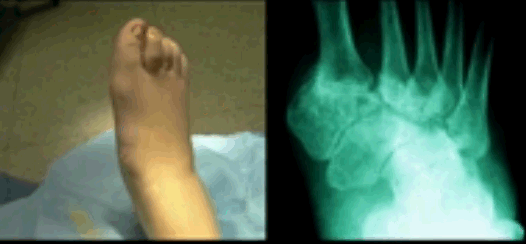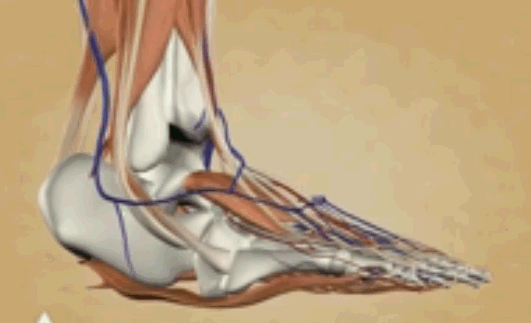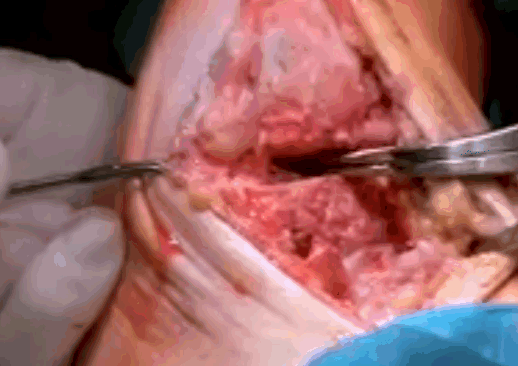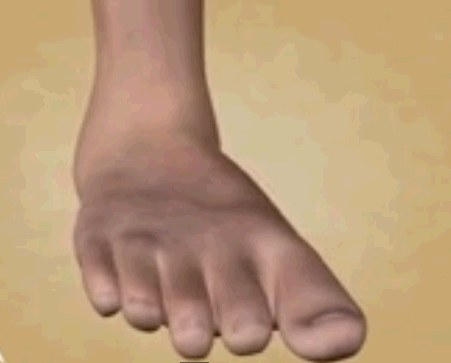Charcot foot is a degenerative condition that weakens the bones of the foot occurring in people with serious nerve damages. The condition is influential on the joints in feet normally found with vascular issues or neuropathy. Neuropathy is a common issue in people with diabetes making them prone to Charcot foot. The bones become extremely weaker and vulnerable to fractures. If an affected individual continue to walk despite of difficulties his/her foot may eventually change shape. Since the condition often co-exists with neuropathic issues the irregularity causes poor muscle balance and foot movement control. The disorder may cause no pain or other symptoms which makes the affected individual unaware of the underlying issue. This is why the patient continues to walk sometimes without addressing the irregularity which makes the condition worse.
Usually Charcot foot causes rocker bottom appearance of the affected foot. Most commonly affected regions under this condition include midtarsal, metatarsal and tarsometatarsal joints. Though the condition commonly affects only one foot in approximately 20% cases patients developed the condition in both foot. If the condition is left untreated then it may continue to damage ligaments, bones as well as cartilages progressively making your foot susceptible to injuries. In serious cases foot amputation may also be needed. Because of the dangers involved, it is crucial for diabetic individuals to stay alert and seek immediate medical advice if any Charcot foot symptoms are detected.
Charcot foot symptoms
Peripheral vascular issues develop over a decade but Charcot foot can affect within weeks or months. Often a minor trauma initiates the process of progressive degeneration of the foot. In some patients lose of pain sensitivity and foot position cause unawareness leading to further injuries to the foot. However, certain symptoms can help determining the existence of the condition.
- The affected foot feels warmer to touch than the other one
- Reddened foot
- Swollen foot
- Dislocation of joint
- Insensitivity developed in foot
- Instable joint or subluxation
- Pain and soreness
- Stronger pedal pulse
- Swollen ankle
- Discoloration of joints
- Obvious deformity of the foot which can be severe.
Causes of Charcot foot
Charcot foot is often said to co-exist with diabetes mellitus and/or peripheral vascular issues (neuropathy). This is why it is stated that patient with diabetes are at increased risk of developing Charcot foot. Neuropathy is commonly associated with the condition as it depletes victims’ ability to sense pain, trauma or increased temperature. This makes the patient unaware of the underlying irregularity. The patient continues to perform his daily activities without addressing the issue which ultimately aggravates the condition causing it to degenerate further. Individual with neuropathy and tighter Achilles tendon are at greater risk of developing the disorder. Diabetes and increased level of glucose in blood can cause neuropathic problems which is why the condition is considered to be common in diabetic individuals.
Charcot foot diagnosis
To successfully treat the condition it is crucial to detect it at its early stages. If you suspect that you are affected with Charcot foot, based on early symptoms, then consult a podiatrist without delay. In some situations diagnosing the condition certainly may become difficult as the irregularity may mimic other issues such as DVT (Deep veins thrombosis) or cellulitis. Existence of this condition cannot be assured until bone alterations are detected. This is why conventional techniques such as x-ray, CT scan, etc may not be as helpful as other methods such as nuclear bone scanning.
Your doctor will probe you on recent activities, symptoms and medical history. He will analyze the affected foot within the clinic itself. Additional tests may be suggested to confirm the beingness of the condition. This is not it; once you are tested positive for the condition and are undergoing treatment you may have to attend diagnosis after timely intervals to track the progress of the condition. In some cases doctor may suggest intricate laboratory tests for which fluid will be derived from your joint to detect presence of bone fragments and cartilages in it. Based on the results suitable treatment will be suggested to you by your doctor.
Charcot foot treatment
Several Charcot foot treatments are available, though the common goal among all is stabilization of joints. While undergoing treatment it is crucial to accurately follow instructions provided by your doctor. The treatment would depend on the stage of the condition. For less serious condition non surgical techniques may be suggested. These practices often include reduce or stop moving (immobilization), use of custom shoes or splints, using crutches, wheelchair, restricting activities that can worsen the condition etc.
In case of seriously aggravated condition surgery may be the only option if deformity is extreme. Ostectomy is the most common invasive procedure suggested for Charcot foot patients. In this operation anomalous bone growth, cartilage and bone fragments are eradicated through an incision at the sole. After the treatment a brace cast is suggested to be worn until the wound is healed.
In some cases ‘realignment arthrodesis’ is suggested that is again an invasive treatment. In this treatment bony overgrowth are eliminated through incision and rectification of collapsed arches are done. The surgery also involves insertion of plates and screws to stabilize the joints. After the procedure it is necessary for the patient to wear cast followed by prolonged use of orthotics unless your doctor suggests discontinuation.
The recovery may take around 8 weeks or even longer. You may also be closely monitored after the surgery for any anomalies. Regular follow-ups with your doctor are also suggested to ensure the condition is completely healed.
Charcot Foot Pictures





